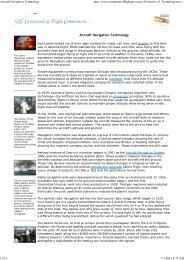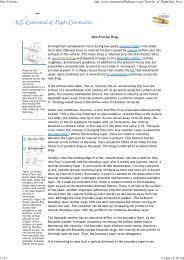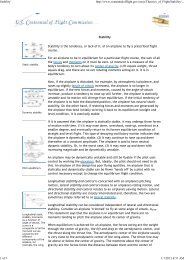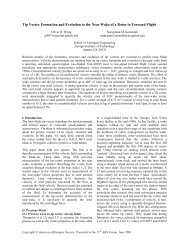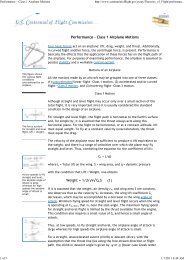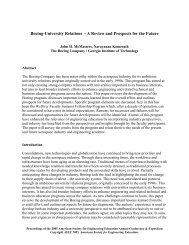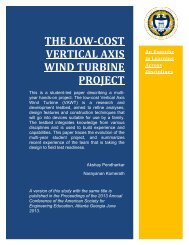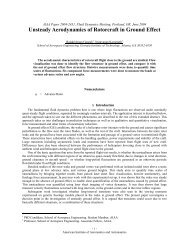Application of Lighter-Than-Air Platforms for Power Beaming ...
Application of Lighter-Than-Air Platforms for Power Beaming ...
Application of Lighter-Than-Air Platforms for Power Beaming ...
You also want an ePaper? Increase the reach of your titles
YUMPU automatically turns print PDFs into web optimized ePapers that Google loves.
TABLE III<br />
OPERATING REQUIREMENTS OF AN AEROSTAT FOR POWER BEAMING<br />
Fig. 2.<br />
Sensitivity <strong>of</strong> envelope volume to ambient wind speeds<br />
Parameter Units Value<br />
Onboard payload mass kg 200<br />
Floating Altitude km 5<br />
Ambient wind Speed m/s 15<br />
Envelope Slenderness ratio [Length/Diameter] NA 3.05<br />
Off standard Temperature degrees ISA+20<br />
Diurnal temperature variation degrees +/- 10<br />
Time on station be<strong>for</strong>e envelope top-up months 4<br />
Envelope material specific mass kg/m2 0.21<br />
Helium leakage rate lit/ m 2 / day 2.5<br />
Tether specific Mass kg/m 0.25<br />
TABLE IV<br />
KEY PARAMETERS AND MASS BREAKDOWN OF AN AEROSTAT FOR POWER<br />
BEAMING<br />
Fig. 3.<br />
Sensitivity <strong>of</strong> envelope volume to operating altitude<br />
Parameter Units Value<br />
Envelope Volume m 3 4111<br />
Envelope Surface Area m 2 1413<br />
Envelope Length m 43<br />
Envelope Diameter m 14<br />
Net Disposable Lift kg 2596<br />
Tether length m 5500<br />
Envelope group Mass kg 353<br />
Elastic Strip mass kg 98<br />
Fin Assembly Mass kg 141<br />
Tether Mass kg 1545<br />
Gross Take Off Empty Mass kg 2137<br />
in detail later as part <strong>of</strong> the architecture design.<br />
V. SENSITIVITY ANALYSES<br />
Sensitivity analyses were carried out to understand the<br />
interdependency <strong>of</strong> key design parameters and to identify<br />
the design drivers i.e., the parameters to which the airship<br />
per<strong>for</strong>mance at the required operating conditions is most<br />
sensitive. Figure 2 illustrates the exponential increase in the<br />
envelope volume with increase in ambient wind speed that<br />
the airship is expected to handle. The increase in size <strong>of</strong> the<br />
envelope if Helium is used instead <strong>of</strong> Hydrogen is also quite<br />
apparent.<br />
Figure 3 illustrates the sensitivity <strong>of</strong> envelope volume to the<br />
operating altitude. It can be seen that the optimum operating<br />
altitude in India is around 21km AMSL. The envelope volume<br />
is larger at lower altitudes than this due to higher ambient wind<br />
velocities, which increase the powerplant size and weight.<br />
Envelope volume is also larger at higher altitude than this,<br />
due to loss in buoyancy <strong>of</strong> the LTA gas.<br />
VI. SIZING OF AN AEROSTAT FOR POWER BEAMING<br />
It is not enough to generate the power using a stratospheric<br />
airship; it is also required to beam this power down to the<br />
ground. A tethered aerostat deployed at an altitude <strong>of</strong> 5<br />
km AMSL could be used <strong>for</strong> this purpose; this operating<br />
height will ensure that the size and weight <strong>of</strong> the onboard<br />
equipment needed <strong>for</strong> this purpose will be quite manageable.<br />
The aerostat altitude may be brought down to 4 km to 5<br />
km with tethered aerostats. The mass per unit length <strong>of</strong> the<br />
tether would probably dictate the optimum altitude in this case.<br />
A methodology <strong>for</strong> sizing <strong>of</strong> a tethered aerostat system<br />
<strong>for</strong> high altitude applications has been developed by Raina<br />
et al. [24]. Using this methodology, an aerostat system was<br />
sized <strong>for</strong> the operating requirements listed in Table III. The<br />
aerostat envelope was assumed to be <strong>of</strong> GNVR pr<strong>of</strong>ile with<br />
three inflatable fins in inverter Y layout. It was assumed that<br />
a total on-board payload carrying capacity <strong>of</strong> 200 kg would<br />
suffice to meet the weight <strong>of</strong> the power beaming equipment. It<br />
was also assumed that the aerostat would be required to stay<br />
afloat <strong>for</strong> a continuous deployment period <strong>of</strong> 4 months in a<br />
year be<strong>for</strong>e the need to top up the gas that would have leaked<br />
out from the envelope.<br />
VII. MILLIMETER WAVEGUIDE REQUIREMENTS AND<br />
SIZING<br />
Given that modern tethers have diameter well over 25<br />
mm and already convey small amounts <strong>of</strong> electrical power<br />
and communication signals, one could consider whether a<br />
tether could be made, that incorporates a waveguide <strong>for</strong><br />
Megawatt-level transmission <strong>of</strong> millimeter wave power.



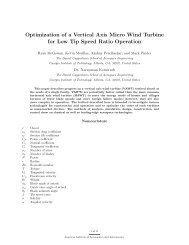
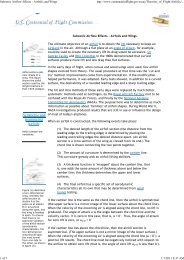

![p density of fluid, kg/m3 [Greek letter rho] V mean velocity of fluid, m ...](https://img.yumpu.com/50595898/1/184x260/p-density-of-fluid-kg-m3-greek-letter-rho-v-mean-velocity-of-fluid-m-.jpg?quality=85)
